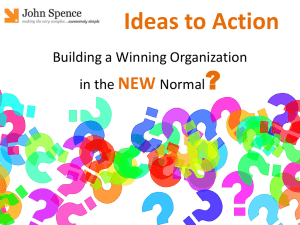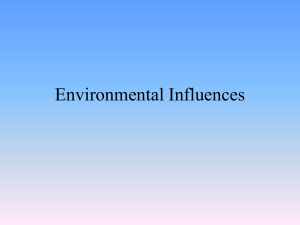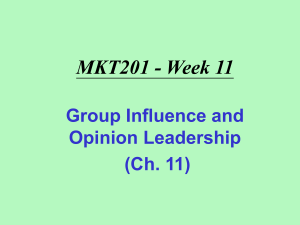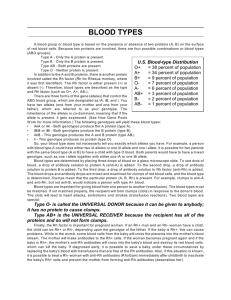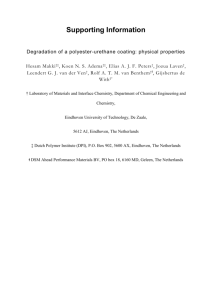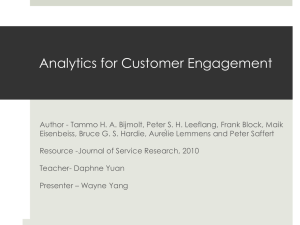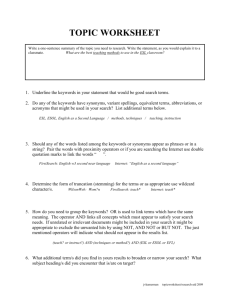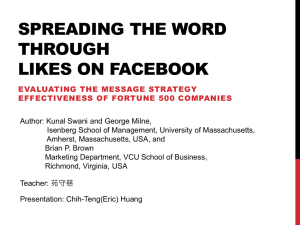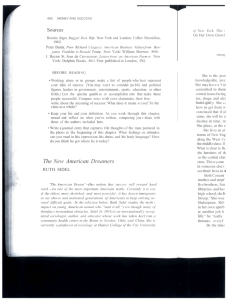Word of mouth: understanding and managing referral
advertisement
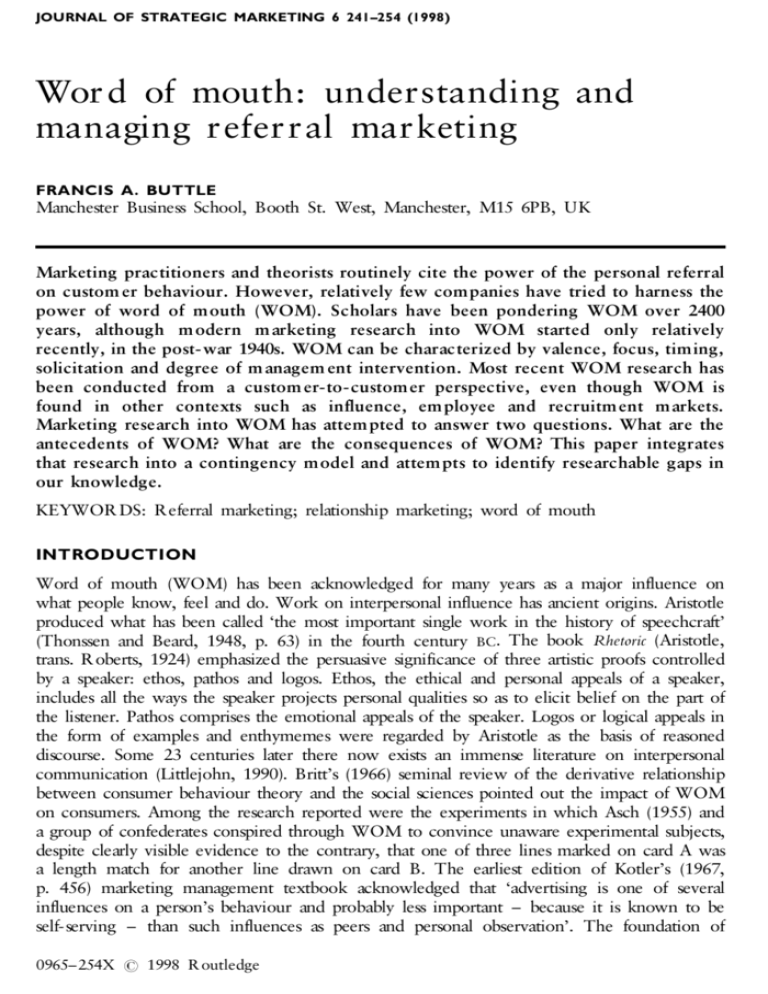
JOURNAL OF STRATEGIC MARKETING 6 241–254 (1998) Word of mouth: understanding and managing referral marketing FRANCIS A. BUTTLE Manchester Business School, Booth St. West, Manchester, M15 6PB, UK Marketing practitioners and theorists routinely cite the power of the personal referral on custom er behaviour. However, relatively few companies have tried to harness the power of word of mouth (WOM). Scholars have been pondering WOM over 2400 years, although m odern m arketing research into WOM started only relatively recently, in the post-war 1940s. WOM can be characterized by valence, focus, timing, solicitation and degree of m anagem ent intervention. Most recent WOM research has been conducted from a custom er-to-custom er perspective, even though WOM is found in other contexts such as influence, em ployee and recruitm ent markets. Marketing research into WOM has attem pted to answer two questions. What are the antecedents of WOM? What are the consequences of WOM? This paper integrates that research into a contingency model and attem pts to identify researchable gaps in our knowledge. KEYWOR DS: Referral marketing; relationship marketing; word of mouth INTRODUCTION Word of mouth (WOM) has been acknowledged for many years as a major influence on what people know, feel and do. Work on interpersonal influence has ancient origins. Aristotle produced what has been called ‘the most important single work in the history of speechcraft’ (Thonssen and Beard, 1948, p. 63) in the fourth century BC. The book Rhetoric (Aristotle, trans. R oberts, 1924) emphasized the persuasive significance of three artistic proofs controlled by a speaker: ethos, pathos and logos. Ethos, the ethical and personal appeals of a speaker, includes all the ways the speaker projects personal qualities so as to elicit belief on the part of the listener. Pathos comprises the emotional appeals of the speaker. Logos or logical appeals in the form of examples and enthymemes were regarded by Aristotle as the basis of reasoned discourse. Some 23 centuries later there now exists an immense literature on interpersonal communication (Littlejohn, 1990). Britt’s (1966) seminal review of the derivative relationship between consumer behaviour theory and the social sciences pointed out the impact of WOM on consumers. Among the research reported were the experiments in which Asch (1955) and a group of confederates conspired through WOM to convince unaware experimental subjects, despite clearly visible evidence to the contrary, that one of three lines marked on card A was a length match for another line drawn on card B. The earliest edition of Kotler’s (1967, p. 456) marketing management textbook acknowledged that ‘advertising is one of several influences on a person’s behaviour and probably less important – because it is known to be self-serving – than such influences as peers and personal observation’. The foundation of 0965–254X # 1998 R outledge 242 BUTTLE WOM’s alleged powers is not expressed here in terms of Aristotle’s three proofs, but of the speaker’s independence. Aristotle, however, would have recognized this as an ethical appeal. Thirty years later, in the late 1990s, marketers, particularly those who espouse the emergent relational paradigm, are keen to harness the power of WOM. THE POWER OF WORD OF MOUTH R esearch generally supports the claim that WOM is more influential on behaviour than other marketer-controlled sources. Indeed, it has been observed that WOM can be more influential than neutral print sources such as Which and Consumer Reports (Herr et al., 1991). WOM has been shown to influence a variety of conditions: awareness, expectations, perceptions, attitudes, behavioural intentions and behaviour. Sheth (1971) concluded that WOM was more important than advertising in raising awareness of an innovation and in securing the decision to try the product. Day (1971) inferred that this was due to source reliability and the flexibility of interpersonal communication. He computed that WOM was nine times as effective as advertising at converting unfavourable or neutral predispositions into positive attitudes. Mangold’s (1987) review of the impact of WOM in the professional services context concluded that WOM has a more emphatic influence on the purchasing decision than other sources of influence. This is perhaps because personal sources are viewed as more trustworthy (Murray, 1991). In the industrial purchasing context, WOM influences expectations and perceptions during the information search phase of the buying process and influences attitude during the pre-choice evaluation of alternative service providers (Lynn, 1987; Stock and Zinsner, 1987; Woodside et al., 1992). The influence of WOM on expectations has been reported by Webster (1991) and Zeithaml et al. (1993). WOM can influence decisions either positively (Engel et al., 1969; Richins, 1983) or negatively (Tybout et al., 1981; Bolfing, 1989). It does appear that negative WOM has a more powerful impact than positive WOM (Arndt, 1967). Technical Assistance R esearch Program (1986, p. 4), for example, reported that dissatisfied customers are likely to tell twice as many people as satisfied customers. Desatnick (1987), citing research conducted for the White House Office of Consumer Affairs asserted that ‘90%or more who are dissatisfied with the service they receive will not buy again or come back. Worse still, each of those unhappy customers will tell his or her story to at least 9 other people, and 13% of those unhappy former customers will tell their stories to more than 20 people’. It is not reported to how many these WOM recipients retell the story. DEFINING WORD OF MOUTH Arndt (1967) was one of the earliest researchers into the influence of WOM on consumer behaviour. He characterized WOM as oral, person-to-person communication between a receiver and a communicator whom the receiver perceives as non-commercial, regarding a brand, product or service (Arndt, 1967). This was an attempt to identify the domain of WOM research. More recently, Stern (1994) defined WOM by drawing on its distinctiveness from advertising. She wrote that ‘WOM differs from [advertising. . .] in its lack of boundaries. . . .WOM involves the exchange of ephemeral oral or spoken messages between a contiguous source and a recipient who communicate directly in real life . . . Consumers are not assumed to create, revise and record pre-written conversational exchanges about products and services. Nor do they ordinarily use poetry or song to discuss consumption. Finally, WOM UNDERSTANDING AND MANAGING REFERRAL MARKETING 243 communication vanishes as soon as it is uttered, for it occurs in a spontaneous manner and then disappears’ (Stern, 1994, p. 7). WOM, however, need not necessarily be brand, product or service focused. It may be organization focused. Neither in this electronic age need WOM be face to face, direct, oral or ephemeral. There is some evidence that virtual WOM through electronic bulletin boards functions analogously to face-to- face WOM. For example, Cobra Golf Inc., the golf equipment manufacturer, has created a bulletin board site on which surfers post unedited messages about Cobra’s own and competitors’ equipment (Hagel and Armstrong, 1997). There is a Web site dedicated to negative WOM about United Airlines (www.united.com). Passengers can report how they have experienced United’s execrable service in the ‘unfriendly skies’. The electronic community in effect generates virtual WOM which is not face to face, direct, oral and ephemeral. The history of electronic WOM is traceable through archival threads. CHARACTERISTICS OF WORD OF MOUTH WOM is mischievously nicknamed free advertising. If advertising can be defined as ‘any paid form of nonpersonal presentation of ideas, goods or services by an identified sponsor’ (Alexander, 1964), then most WOM is not. Advertising, by this definition, is paid, nonpersonal, transparently sponsored communication. These distinguishing characteristics of WOM are being eroded. Some WOM is incentivized and rewarded, while other WOM is produced electronically. Perhaps all that distinguishes WOM is that it is uttered by sources who are assumed by receivers to be independent of corporate influence. WOM can be characterized by valence, focus, timing, solicitation and intervention. Vale nce From a marketing perspective, WOM can be either positive or negative. Positive WOM occurs when good news testimonials and endorsements desired by the company are uttered. Negative WOM is the mirror image. It is worth noting that what is negative from a corporate viewpoint may be regarded as extremely positive from a consumer viewpoint. According to File et al. (1994) not only the valence but also the volume of post-purchase WOM can be affected by management efforts. These authors cited evidence that the measured impacts of complaints management processes, service recovery programmes and unconditional service guarantees on post-purchase WOM is clear evidence that management can influence the frequency and direction of WOM. Focus We have assumed thus far that management’s focus is only on WOM between consumers. This need not be so. Relationship marketing’s six-markets model (Fig. 1) points out that marketers are concerned with building and maintaining mutually beneficial relationships in a variety of domains: customers (which may be end users or intermediaries), suppliers=alliances, employees, influentials, recruitment and referral markets (Christopher et al., 1991). The clear focus of most management writings on WOM is that of the satisfied customer communicating with a prospect. Put another way, the assumption is that WOM functions to BUTTLE 244 supplier/alliance referral internal customer influencer FIGURE 1. recruitment The six-markets model. draw customers onto the loyalty ladder (Fig. 2), thereby converting a prospect into a customer (Christopher et al., 1991). Indeed, evidence of a powerful role for WOM in the diffusion of innovations is well documented (Mahajan et al., 1990). However, whilst it is conceivable that some WOM functions to migrate a customer up company X’s loyalty ladder, other WOM may equally promote defection off company X’s loyalty ladder. Although research is thin, it seems self-evident that WOM can operate in the other five markets. For example, WOM can influence investment decisions (influence markets). WOM is also an important source of information in the recruitment market. One engineering company, for example, estimates that 80% of its employees are recruited following personal referrals. Indeed, some companies reward their employees for recruiting suitable people. R ewards ranging from $50 to $2000 have been paid (Tyler, 1996). WOM is also the primary form of action in which organizational culture is expressed and reconstituted, therefore having a considerable impact on the behaviour of employees. Partner Advocate Supporter Client Customer Prospect FIGURE 2. The loyalty ladder. UNDERSTANDING AND MANAGING REFERRAL MARKETING 245 Tim ing R eferral WOM might be uttered either before or after a purchase. WOM can operate as an important source of pre-purchase information. This is known as input WOM. Customers may also utter WOM after the purchase or consumption experience. This is known as output WOM. S olicitation Not all WOM communication originates from customers. Indeed, WOM may be offered with or without solicitation; it may or may not be sought. However, when authoritative information is sought, the listener might seek the input of an opinion leader or influential. Intervention Although WOM can be spontaneously generated, an increasing number of companies are pro-actively intervening in an effort to stimulate and manage WOM activity. Managed WOM may operate at an individual or organizational level. Individuals may be sought who themselves actively deliver WOM or who serve as role models for those who would follow. Companies are alert to the potential problems associated with celebrity endorsements. Celebrities can become unfashionable or attract bad publicity. Michael Jackson, O.J. Simpson and Eric Cantona are cases in point. TAXONOMY OF REFERRALS A.F.T. Payne (unpublished) developed a taxonomy of referral types, broadly split into two groups: customer referrals and non-customer referrals. Customer referrals may be either customer initiated or company initiated. Customer-initiated referrals originate from current or former customers who have been satisfied or delighted with their experiences. They act as unpaid advocates (see Fig. 1). A number of companies are attempting to harness the power of WOM by giving customers incentives to refer their friends and family: American Express, British Telecom and Freemans Home Shopping are examples. In addition to these customer referrals, companies may benefit from a number of other referral sources. Reciprocal referrals occur when two or more organizations agree to cross-refer customers to each other. This is commonplace in professional services marketing; law firms, estate agents and building societies, for example, often develop a referral network. Some referral activities may be unidirectional: a doctor may recommend a consultant or an architect may specify a particular contractor. Internal referrals within an organization may be fruitful. Divisionalized organizations, such as accounting firms, may cross-refer clients between divisions, for example audit customers might be targeted for consultancy services. R eferrals from current or past employees may also benefit a company. THE WORD-OF-MOUTH MODEL This inclusive model of WOM (Fig. 3) contains two sets of variables. (1) Intrapersonal variables: these are states or processes which are associated either with seeking input WOM or precipitating output WOM. BUTTLE 246 EXTRAPERSONAL ENVIRONMENT SOCIAL NETWORKS CULTURE INCENTIVES BUSINESS CLIMATE INTRAPERSONAL ENVIRONMENT INPUT WOM seeking giving delight giving OTHER INFLUENCES ON EXPECTATION DISCONFIRMATION PROCESS Expectation: Perception satisfaction FIGURE 3. seeking OUTPUT WOM OTHER BEHAVIOURS dissatisfaction Word-of-mouth model. (2) Extrapersonal variables: these are contextual conditions which influence the seeking of input WOM or the production of output WOM. Intrapersonal variables The production of output WOM is widely thought to be an outcome of customer experiences with a product or service. The disconfirmation paradigm of customer satisfaction=dissatisfaction predicts that in most commercial contexts when a customer’s expectations are met satisfaction will be experienced, when expectations are underperformed there will be dissatisfaction and when expectations are exceeded there will be customer delight (Oliver, 1997). Satisfaction and delight, it is believed, motivate positive WOM. There is some evidence from the service sector that delight is less likely to be associated with ‘right first time’ service delivery than it is with excellent recovery following service failure (TARP, 1986) and it has been estimated that it is generally cost-effective for management to invest twice the profit margin associated with a sale to recover a dissatisfied customer (Fornell and Wernerfelt, 1986). Similarly, negative WOM can be conceptualized as an outcome of an unsatisfactory imbalance between expectations and perceptions. Several researchers have investigated the possibility of there being a hierarchy of expectations. The Yale Communication and Attitude Change Program, which prolifically researched the relationship between mediated communication and attitude during the 1950s, wrote of a latitude of acceptance (Hovland et al., 1957). Miller (1977) wrote of four levels of expectations ranging from ideal to lowest acceptable. He referred to these as the ‘can be’, ‘will be’, ‘must be’ and ‘should (or ought to) be’ levels of expectation. Parasuraman et al. UNDERSTANDING AND MANAGING REFERRAL MARKETING 247 (1991) wrote of expectations being bounded by adequate (minimum) and desired levels. These form a zone of tolerance for consumers. Woodruff et al. (1983) have conceptualized a narrower band of reasonable expectation they dubbed the zone of indifference. More recently, Strandvik (1994) reviewed the literature on tolerance zones and Oliver (1997) produced an integrated conceptualization of expectations research (see Fig. 4). It seems plausible to infer that positive WOM is associated with performance above that which was predicted and negative WOM with performance below that which was wanted. Westbrook (1987) reported that WOM is mediated by satisfaction levels. Swan and Oliver (1989) reported that (positive) WOM increases as satisfaction increases. Engel et al. (1969), however, contended that emotional response to product=service performance evokes WOM directly. There is some early evidence that WOM is driven not only by product=service performance but by dis=satisfaction with the purchasing process (Tanner, 1996). Hartline and Jones (1996) concluded that intention to utter WOM is correlated with the customer’s perceptions of value and quality. The higher those perceptions the stronger the intention of uttering positive WOM. The stronger of the two correlates is value. Given that certain components of the service delivery process signal ‘value’ to customers, it makes sense for management to isolate these dimensions and develop them to promote referrals. There is evidence that customers who perceive that they are offered social support in a service encounter are more prepared to recommend the service (Adelman and Ahuvia, 1995). Social support is found when service providers’ verbal or non- verbal communication increases the customer’s sense of control by reducing their uncertainty, improves customer self-esteem or enhances the customer’s sense of social connection to others (Adelman et al., 1993). Social support is particularly found within strong- tie relationships. We experience everyday weak-tie support in relationships with strangers, casual acquaintances and service providers. Where service providers are able to strengthen the tie by providing social support, there is a greater propensity to utter positive WOM. Social support in the professional services environment (e.g. lawyers and GPs) is strongly correlated with client satisfaction. Wanted Ideal Tolerance zone `Excellence’ Desired Zone of indifference Deserved Needed Adequate Minimum Tolerable Predicted FIGURE 4. Intolerable Expectations according to level of desirability. 248 BUTTLE Negative valent output WOM has been researched in several purchasing contexts including cars (Swan and Oliver, 1989) and hotel accommodation (Cadotte and Turgeon, 1988), as well as in the not- for-profit context (Cermak et al., 1991). Just as positive WOM has been linked to satisfaction, so has negative WOM been linked to dissatisfaction (Singh and Pandya, 1991). Negative output WOM is thought to be one form of customer complaining behaviour (CCB). Hirschman (1970) proposed that customers have two options when faced with unmet expectations: voice their dissatisfaction or exit the relationship. Theoreticians have more recently conceptualized three forms of punitive action that a dissatisfied customer could take: exit the relationship, voice dissatisfaction to the supplier and utter negative WOM to a social network. Singh (1988) applied cluster analysis to complaints data and found evidence of a tripartite taxonomy of complaint style: voice responses (complain to and seek redress from the supplier), private responses (negative personal WOM) and third party responses (e.g. write to a consumer affairs programme or consult a solicitor). There is general support for the contention that customers dissatisfied with durables will exhibit higher levels of voice and lower levels of exit than for non-durables (Watkins and Liu, 1996). Singh (1990) explained this phenomenon in terms of the relative investment of the customer in the product=service and, thus, the value of any redress. Different conditions may be associated with the utterance of negative and positive WOM. In a health service context, the service characteristics of reliability and dependability are most closely associated with the utterance of positive WOM and appearance and presentation with the utterance of negative WOM (Headley and Miller, 1993). As already noted, after purchases are made, consumers will often make comparisons between their expectations and the product performance they experience. If performance is below expectation, the customer might sense dissonance. Cognitive dissonance theory has a 40 year old tradition in marketing thought (Festinger, 1957). Cognitive dissonance is definable as an imbalance in a cognitive system. Two elements in such a system are expectations and perceptions of product performance. One available strategy for customers who experience discomfort from cognitive dissonance is to seek WOM from sources which can reduce the discomfort. However, not all customers feel discomfort. Until the 1940s, marketing communication thought was dominated by the ‘magic bullet’ or ‘inoculation’ theory of mass communication. It had been assumed that mass media messages impacted directly upon all audience members. In the late 1940s, however, Lazarsfeld et al.’s (1948) study of voting behaviour indicated that mass media messages were intercepted and distributed by strategically situated individuals they called opinion leaders. The two- step flow hypothesis suggests that marketer-controlled communication flows to opinion leaders who in turn communicate it through WOM to their peers, thereby influencing their attitudes and behaviours. In this theory, opinion leaders are distributed at all levels and in all groupings of society and may be influential on just one or several topics. Katz and Lazarsfeld (1955), for example, profiled different attributes for food opinion leaders, fashion opinion leaders, public affairs opinion leaders and film-going opinion leaders. Rogers (1962), however, claimed to have identified three traits which broadly typified all opinion leaders: social participation, social status and cosmopolitanism. Robertson (1971), in turn, claimed that in terms of cosmopolitanism, leaders were barely distinguishable from followers, but that they were more gregarious, more knowledgeable (for the area of expertise) and more innovative. Knowledge is commonly assumed to be a determinant of personal influence (Solomon, 1992). Engel et al. (1993) preferred to call these persons influentials rather than opinion leaders. They noted that influentials’ demographic characteristics vary between products, but that they UNDERSTANDING AND MANAGING REFERRAL MARKETING 249 are generally more gregarious, fashion conscious, independent, innovative and active in information search. Opinion leadership theory has been subjected to much critical research and a multistep theory of communication effects is now coming into broader acceptance. In the multistep world, both opinion leaders and followers are legitimate targets for differentiated messages. Followers, for example, may be motivated to seek information. Recent work by Yale and Gilly (1995) suggested that information seekers do not necessarily select information sources matching the common profile for opinion leadership as deployed in the marketing literature, but will select persons whom they believe to be high in product knowledge. Both the information seeker and the source perceive the source to be more knowledgeable than the recipient in the area of consultation (Yale and Gilly, 1995). In the 1980s, the concept of the ‘market maven’ was developed. This is a person who enjoys advising friends of new products=services and places to shop (Feick and Price, 1987; Higie et al., 1987). It is the social integration of the maven rather than any product- related expertise that gives them their power. Market mavens are largely women but indistinguishable in other ways (Bayus et al., 1985; Higie et al., 1987). Gelb and Johnson (1995, p. 56) noted that ‘not only does the market maven prompt word of mouth, but those with links to such individuals are disproportionately likely to act on what they are told’. Extrapersonal variables Although WOM is undoubtedly a universal phenomenon, most published English-language research has been undertaken in Western economies. In Western culture the person is viewed as a self-contained, autonomous individual. According to Markus and Kitayama (1991, p. 224) ‘the Western view of the individual as a self-contained, autonomous entity who (a) comprises a unique configuration of internal attributes (e.g. traits, abilities, motives, values), and (b) behaves primarily as a consequence of these internal attributes’ has dominated the scientific literature. However, not all cultures view the person as independent. At the opposite end of the spectrum, there are cultures which take an interdependent view of personhood. According to Markus and Kitayama (1991, p. 227) ‘experiencing interdependence entails seeing oneself as part of an encompassing social relation and recognizing that one’s behavior is determined, contingent on, and to a large extent, organized by what the actor perceives to be the thoughts, feeling and actions of others in the relationship’. This paper’s review of WOM research has captured only that conducted at the individualist end of the individualist=collectivist spectrum. The relevance of this research in Asian, African, Mediterranean, Middle Eastern and Latin American cultures is questionable. If persons in collectivist cultures subordinate their individuality to the collective, this may well have relevance to WOM activity, whether seeking or giving and whether positive or negative. For example, in a collectivist culture negative WOM about a personally unsatisfactory experience may not be uttered if the collective view is generally favourable. Collectivists may be more likely to develop strong emotional ties to products and services when they are signs of group membership and to want to develop strong, trusting relationships with suppliers. Some researchers have begun investigating cultural differences in attitudes towards complaining (Arndt et al., 1982; Thorelli, 1983; Richins and Verhage, 1985). Watkins and Liu (1996) discussed the cultural limitations of WOM research. It does appear that culture is an extrapersonal condition which impacts upon WOM behaviours. The culturally situated extant research does, however, indicate that a number of other extrapersonal conditions impact upon WOM seeking and WOM utterance. The seeking of 250 BUTTLE input WOM may be particularly significant for high risk or intangible-dominant products (File et al., 1994). Many consumers experience perceived risk in new product-purchasing contexts. This risk can take several forms – physical, performance, financial, social, psychological or time loss (Mitchell and Hogg, 1996). Reference to WOM is a risk reduction strategy which can do much to reduce or eliminate the uncomfortable feeling of risk exposure. WOM is a more important input to the decision process when purchasing services, rather than goods. Murray (1991) found that service consumers prefer to seek information from family, friends and peers rather than sponsored promotional sources. Services are high in credence properties which are difficult to evaluate prior to consumption. Service intangibility and the potential for heterogeneous performance drive WOM seeking. Gombeski et al.’s (1988) review of patient questionnaires found that 50% of new patients reported that peer referral to a health centre had the most influence on the patronage decision. The limitations of WOM are illustrated by Johnson and Meischke’s (1991) finding that patients preferred to receive information about cancer treatment from doctors than from family and friends. In the professional services context, buyers are known to seek input from other customers. This is weighted very highly in the buying decision (Kotler and Bloom, 1984; Gould, 1988). A survey of 324 chief executive officers (CEOs) in six industries identified ‘a personal endorsement of the professional service firm from a business associate’ (File et al., 1994, p. 308) as very important in the service provider selection decision. Output WOM has also been associated with price. R ichins (1983, 1987) found that the higher the price the greater the likelihood of negative WOM being uttered if the product fails to satisfy. This again can be accounted for by the relative consumer investment in the product=service. All forms of CCB increase with the perceived importance of the problem (Folkes et al., 1987). Output WOM has also been associated with conditions in the business environment. Voice and exit behaviours vary inversely with the level of concentration in an industry. The more concentrated, the fewer alternatives the customer has in the face of dissatisfaction (Fornell and Didow, 1980). As the difficulty or cost of expressing dissatisfaction rises, the expression of voice response declines, but the incidence of exit increases. The more receptive a supplier is thought to be to customer complaint the lower the incidence of exit and voice behaviours (Richins, 1983, 1987). Attribution theory suggests that when the supplier is held accountable for dissatisfaction, all three forms of CCB increase (Folkes et al., 1987). Researchers have identified a number of specific contexts which evoke consumer WOM. Bayus (1985) observed that frequent repetitive advertising can increase WOM, particularly in the absence of other information sources. Ambiguity in advertising matter may also provoke comment (King and Tinkhan, 1990). These findings are in keeping with the advertising axiom that it is vital to create advertisements high in ‘conversational value’ and consistent with the evidence that, if an advertising message generates uncertainty about a product=service, consumers will seek WOM in order to reduce perceived risk. RESEARCH QUESTIONS Several research questions emerge from this review. (1) Which is better at predicting intention to utter WOM or actual behaviour: the disconfirmation or attitudinal paradigm? UNDERSTANDING AND MANAGING REFERRAL MARKETING 251 (2) Does WOM covary more directly with perception or disconfirmation of value, satisfaction or quality? Under what contextual conditions? (3) Which antecedent marketing conditions are most closely associated with WOM? In the service sector, which of the 7Ps – product, price, place, promotion, people, process and physical evidence – has the greatest impact on WOM? Under what contextual conditions? (4) How is intention to utter WOM connected to actual performance? What conditions, if any, enable or constrain performance? R esearchers could also extend the focus of WOM investigation. (5) How can we better understand the effects of WOM in influence, recruitment and internal markets? Since companies are beginning to invest in formal referral marketing programmes, a number of questions could be addressed. (6) How effective are existing referral programmes in generating enquiries, trial, retention and switching behaviours? (7) What is the attitude of the referring customer and the referred customer to these programmes and to the companies sponsoring the programmes? Finally, since most of the research published in the English language has been undertaken in Western economies, there are a number of unanswered cross-cultural issues of interest to managers in multinational companies (MNCs) and theoreticians. (8) How does WOM operate in cultures other than Western? (9) What do MNC managers need to do differently to promote positive output WOM? REFERENCES Adelman, M.B. and Ahuvia, A.C. (1995) Social support in the service sector: the antecedents, processes and outcomes of social support in an introductory service. Journal of Business Research 32, 273– 82. Adelman, M.B., Ahuvia, A.C. and Goodwin, C. (1993) Beyond smiling: social support and service quality. In R. Rust and R. Oliver (eds) Frontiers in Service Quality. Newbury, CA: Sage. Alexander, R.S. (1964) Marketing Definitions. Chicago: American Marketing Association. Aristotle, Rhetoric, trans. W.R. Roberts (1924) New York: Oxford University Press. Arndt, J. (1967) Role of product- related conversations in the diffusion of a new product. Journal of Marketing Research 4, 291–5. Arndt, J., Barksdale, H.C. and Perreault, W.D. (1982) Comparative study of attitudes towards marketing, consumerism and government regulation. In H.K. Hunt and R.L. Day (eds) New Findings on Consumer Dissatisfaction and Complaining. Bloomington, IN: Indiana University. Asch, S.E. (1955) Opinions and social pressure. Scientific American 193, 31–5. Bayus, B.L. (1985) Word-of-mouth: the indirect effects of marketing efforts. Journal of Advertising Research 25, 31–9. Bayus, B.L., Carroll, V.P. and Rao, A.G. (1985) Harnessing the power of word-of-mouth. In V. Maha (ed.) Innovation Diffusion Models of New Product Acceptance. Cambridge, MA: Ballinger. Bolfing, C.P. (1989) How do customers express dissatisfaction and what can service marketers do about it? Journal of Services Marketing 3(2), 5– 23. Britt, S.H. (1966) Consumer Behaviour and the Behavioural Sciences. New York: John Wiley. Cadotte, E.R. and Turgeon, N. (1988) Satisfiers and dissatisfiers: suggestions from consumer complaints 252 BUTTLE and compliments. Journal of Consumer Satisfaction, Dissatisfaction and Complaining Behavior 1, 74–9. Christopher, M.G., Payne, A.F.T. and Ballantyne, D. (1991) Relationship Marketing. London: Heinemann. Day, G.S. (1971) Attitude change, media and word of mouth. Journal of Advertising Research 11(6), 31– 40. Desatnick, R.L. (1987) Managing to Keep the Customer. San Francisco, CA: Jossey-Bass. Engel, J.F., Kegerris, R.J. and Blackwell, R.D. (1969) Word of mouth communication by the innovator. Journal of Marketing 33, 15– 19. Engel, J.F., Blackwell, R.D. and Miniard, P.W. (1993) Consumer Behaviour, 7th edn. New York: Dryden Press. Feick, L.F. and Price, L.L. (1987) The market maven: a diffuser of marketplace information. Journal of Marketing 51, 83– 97. Festinger, L.A. (1957) A Theory of Cognitive Dissonance. Stanford: Stanford University Press. File, K.M., Cermak, D.S.P. and Prince, R.A. (1994) Word-of-mouth effects in professional services buyer behaviour. The Service Industries Journal 14(3), 301– 14. Folkes, V., Koletsky, S. and Graham, J.L. (1987) A field study of causal inferences and consumer reaction: the view from the airport. Journal of Consumer Research 13, 534– 9. Fornell, C. and Didow, N.M. (1980) Economic constraints on consumer complaining behavior. In J.C. Olsen (ed.) Advances in Consumer Research, Vol. 7. Ann Arbor, MI: Association for Consumer Research, pp. 318–23. Fornell, C. and Wernerfelt, B. (1986) A Model for Customer Complaint Management. Graduate School of Business, University of Michigan, Ann Arbor, MI. Gelb, B. and Johnson, M. (1995) Word-of-mouth communication: causes and consequences. Journal of Health Care Marketing 15(3), 54– 8. Gombeski, W.R., Fay, G.W., Niedzielski, K.R. and Weaver, F.J. (1988) Evaluating promotional strategy effectiveness for a health care organization. Journal of Business Research 17, 81– 90. Gould, S.J. (1988) Service opinion leadership: a management tool for service providers and product marketers alike. Journal of Professional Services Marketing 4(1), 3– 13. Hagel, J., III and Armstrong, A.G. (1997) Net gain; expanding markets through virtual communities. The McKinsey Quarterly 1, 140– 53. Hartline, M.D. and Jones, K.C. (1996) Employee performance cues in a hotel service environment: influence on perceived service quality, value and word of mouth intentions. Journal of Business Research 35, 207– 15. Headley, D.E. and Miller, S.J. (1993) Measuring service quality and its relationship to future consumer behavior. Journal of Health Care Marketing 13, 32– 41. Herr, P.M., Kardes, F.R. and Kim, J. (1991) Effects of word-of-mouth and product attribute information on persuasion: an accessibility-diagnosticity perspective. Journal of Consumer Research 17, 454–62. Higie, R.A., Feick, L.F. and Price, L.L. (1987) Types and amount of word-of-mouth communications about retailers. Journal of Retailing 63, 260–78. Hirschman, A.O. (1970) Exit, Voice and Loyalty: Responses to Decline in Firms, Organizations and States. Cambridge, MA: Harvard University Press. Hovland, C.I., Harvey, O.J. and Sherif, M. (1957) Assimilation and contrast effects in reactions to communication and attitude change. Journal of Abnormal and Social Psychology 55, 244– 52. Johnson, J.D. and Meischke, S.F. (1991) Cancer information: women’s source and content preferences. Journal of Health Care Marketing 11, 37– 44. Katz, E. and Lazarsfeld, P. (1955) Personal Influence. New York: Free Press. King, K.W. and Tinkhan, S.F. (1990) The learning and retention of outdoor advertising. Journal of Advertising Research 29 (Dec=Jan), 47– 51. Kotler, P. (1967) Marketing Management: Analysis, Planning and Control. Englewood Cliffs, NJ: PrenticeHall. UNDERSTANDING AND MANAGING REFERRAL MARKETING 253 Kotler, P. and Bloom, P.H. (1984) Marketing Professional Services. Engelwood Cliffs, NJ: Prentice-Hall. Lazarsfeld, P., Berelson, B. and Gaudet, H. (1948) The People’s Choice. New York: Columbia University Press. Littlejohn, S.W. (1990) Theories of Human Communication, 2nd edn. Belmont, CA: Wadsworth. Lynn, S.A. (1987) Identifying buying influences for a professional service: implications for marketing efforts. Industrial Marketing Management 16, 119– 30. Mahajan, V., Muller, E. and Bass, F.M. (1990) New product diffusion models in marketing: a review and directions for research. Journal of Marketing 54(1), 1– 26. Mangold, G.W. (1987) Use of commercial sources of information in the purchase of professional services: what the literature tells us. Journal of Professional Services Marketing 3(1=2), 5– 17. Markus, H. and Kitayama, S. (1991) Culture and self: implications for cognition, emotion and motivation. Psychological Review 98(2), 224– 53. Miller, J.A. (1977) Studying satisfaction, modifying models, eliciting expectations, posing problems and making meaningful measurements, in H.K. Hunt (ed.) Conceptualization and Measurement of Consumer Satisfaction and Dissatisfaction. Cambridge, MA: Marketing Science Institute, pp. 72–91. Mitchell, V.W. and Hogg, M. (1996) Exploring the risk=motivation relationship. In P. Harris et al. (eds) Marketing without Borders. Manchester: Academy of Marketing, Manchester Metropolitan University, pp. 627–35. Murray, K.B. (1991) A test of services marketing theory: consumer information acquisition activities. Journal of Marketing 55, 10– 25. Oliver, R.L. (1997) Satisfaction. Singapore: McGraw Hill. Parasuraman, A., Berry, L.L. and Zeithaml, V.A. (1991) Understanding consumer expectations of service. Sloan Management Review 321, 39–48. Richins, M.L. (1983) Negative word- of-mouth by dissatisfied customers: a pilot study. Journal of Marketing 47, 68– 78. Richins, M.L. (1987) A multi-variate analysis of response to dissatisfaction. Journal of the Academy of Marketing Science 15, 24–31. Richins, M.L. and Verhage, B.J. (1985) Cross-cultural differences in consumer attitudes and their implications for complaints management. International Journal of Research in Marketing 2, 197– 296. Robertson, T.S. (1971) Innovative Behaviour and Communication. New York: Holt, Rinehart and Winston. Rogers, E.M. (1962) Diffusion of Innovations. New York: Free Press. Sheth, J.N. (1971) Word of mouth in low risk innovations. Journal of Advertising Research 11, 15– 18. Singh, J. (1988) Consumer complaints intentions and behavior: definitional and taxonomical issues. Journal of Marketing 52, 93– 107. Singh, J. (1990) Voice, exit and negative word- of-mouth behaviors across three service categories. Journal of the Academy of Marketing Science 18, 1– 16. Singh, J. and Pandya, S. (1991) Exploring the effects of consumers’ dissatisfaction level on complaint behaviours. European Journal of Marketing 25(9), 7– 21. Solomon, M.R. (1992) Consumer Behaviour. Boston, MA: Allyn & Bacon. Stern, B. (1994) A revised model for advertising: multiple dimensions of the source, the message, and the recipient. Journal of Advertising 23(2), 5–16. Stock, J.R. and Zinsner, P.H. (1987) The industrial purchase decision for professional services. Journal of Business Research 15, 1– 16. Strandvik, T. (1994) Tolerance Zones in Perceived Service Quality. Helsinki: Swedish School of Economics and Business Administration. Swan, J.E. and Oliver, R.L. (1989) Postpurchase communications by consumers. Journal of Retailing 65(2), 516–33. Tanner, J.F., Jr (1996) Buyer perceptions of the purchase process and its effects on customer satisfaction. Industrial Marketing Management 25, 125–33. TAR P (1986) Consumer Complaint Handling in America: Summary of Findings and Recommendations. Washington, DC: White House Office of Consumer Affairs. 254 BUTTLE Thonssen, L. and Beard, A.C. (1948) Speech Criticism: The Development of Standards for Rhetorical Appraisal. New York: Ronald Press. Thorelli, H.B. (1983) China: consumer voice and exit. In H.K. Hunt and R.L. Day (eds) Consumer Satisfaction, Dissatisfaction and Complaining Behavior. Bloomington, IN: Indiana University. Tybout, A.M., Calder, B.J. and Sternthal, B. (1981) Using information processing theory to design marketing strategies. Journal of Marketing Research 23, 73–9. Tyler, K. (1996) Employees can help recruit new talent. HR Magazine September, 57– 60. Watkins, H.S. and Liu, R. (1996) Collectivism, individualism and in-group membership: implications for complaining behaviors in multi-cultural contexts. Journal of International Consumer Marketing 8(3=4), 69– 96. Webster, C. (1991) Influences upon consumer expectations of services. Journal of Services Marketing 5, 516–33. Westbrook, R.A. (1987) Product=Consumption-based effective response and post-purchase processes. Journal of Marketing Research 24, 258– 70. Woodruff, R.B., Cadotte, E.R. and Jenkins, R.L. (1983) Modeling consumer satisfaction processes using experience-based norms. Journal of Marketing Research 20, 296–304. Woodside, A., Wilson, E.J. and Milner, P. (1992) Buying and marketing CPA services. Industrial Marketing Management 21, 265–73. Yale, L.J. and Gilly, M.C. (1995) Dyadic perceptions in personal information search. Journal of Business Research 32, 225– 37. Zeithaml, V.A., Berry, L.L. and Parasuraman, A. (1993) The nature and determination of customer expectation of service. Journal of the Academy of Marketing Science 21(1), 1–12.
